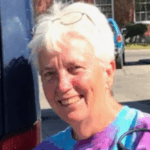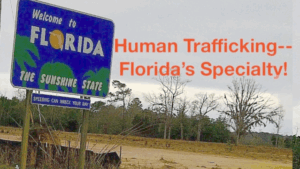
Editor’s note: See original story here.
The Sunshine State (where I grew up) draws visitors and new residents by the millions, attracted by sunshine, beaches, favorable tax structures, and a vibrant human trafficking industry, that last “feature” the subject of a new report that documents an astounding level of nefarious behavior evidently overlooked by law enforcement.
This new report, 2024 TIPSTR State Report on Human Trafficking, indicates that 700,000 total victims — including an appalling 100,000 children — were victims of human trafficking last year in Florida, the Sunshine State. But stuff like this tends to be underreported, with victims unnoticed, so the report numbers are likely lower than those actually being trafficked.
With the focus on Jeffery Epstein and his accomplice-in-chief, our White House occupant, and their sexual escapades, little attention is being given to the young girls left in the wake of these billionaire abusers. Little attention has been given to the harm that sexual abuse does to those being abused.
Let me take you down one rabbit hole of the impact, focusing on kids experiencing homelessness. FYI, Florida schools identified more than 93,000 homeless students (K-12) in the 2022–23 school year (not including babies and toddlers, or older youth).
Who is harmed by abuse?
Not all children and youth in various homeless situations have been abused, but plenty have, in unimaginable ways you don’t want me go into. Spending more than half my life working with homeless adults and children, I’ve heard enough accounts of what happened to them, most often as kids. I’ve gained a deep understanding of why they may have “issues” as adults. Trauma of that nature often leaves significant psychological scars that can impact not only mental health, but also physical wellbeing. Plenty of competent research covers that angle, though it seems not enough to bump up this issue to something that concerns policymakers or law enforcement.
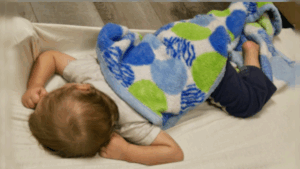
Not to belabor the Epstein saga exploding in news media, but a point often overlooked needs to be made. When a child of any age is abused — sexually, physically, psychologically, or a combination of those horrors — it causes a life-changing, devastating impact to them. The abuser flits away. The abused kids, often discarded like trash, are left with immeasurable damage. It’s not “no big deal.” It’s an outrageous crime against humanity.
But who cares — it’s just kids
Let’s step back and consider how important (or not) we consider kids. We were all kids at one time, so it’s an issue that everyone should understand.
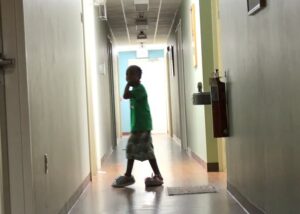
Why is it so hard to understand what kids’ basic needs are that need to be met? Why is it so easy for lawmakers and policymakers to keep kids from having their needs met? Like housing. Food. Health care. Education. Safe environment, and care.
Case (1) in point, keeping them safe
Causes of kids falling into trafficking are many, but often basic and common. Early abuse often creates vulnerability that makes a child susceptible to trafficking.
Many people don’t know that abuse can affect their lives many years later, and do not connect the common effects of trauma to experiences of childhood abuse… Often, the care provider sees the trauma effects (e.g., substance use, depression) as the problem, rather than as a result of trauma. — Recognizing the Effects of Abuse-Related Trauma
The abused kids, often discarded like trash, are left with immeasurable damage. It’s not “no big deal.” It’s an outrageous crime against humanity.
Case (2) in point, keeping them safe
When families can’t afford/attain/maintain their basic needs, they often lose their housing. They may bounce around, doubling up, staying in motels, sleeping in cars, “camping” with/without adequate shelter, staying in abandoned buildings, etc. All forms of homelessness.
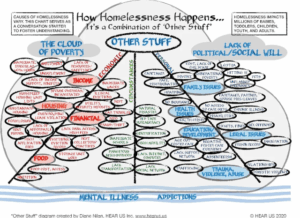
Homelessness 101
Homelessness doesn’t follow stereotypes normally used to describe it. My “Other Stuff” chart and description illustrates many issues accompanying homelessness. Nothing simple about this issue. One thing for sure, without a secure place to live, life, especially for kids, life is extremely perilous, placing them at great risk, vulnerable to “tempting” offers that are often exploitive.
Of course, housing stability — subsidized housing for millions — is now under attack by this current White House occupant, who has…submitted a discretionary budget proposal for the 2026 fiscal year that would introduce drastic changes to how HUD has traditionally operated. One of the biggest changes is introducing a two-year time limit for people living in government-subsidized housing. — Newsone
Researchers at NYU have determined that 2.1 million, with 1 million children, could be impacted by this policy. In addition to the unconscionable impact of evicting 2.1 million households, many who would end up homeless, it would wreak havoc to beleaguered public housing agencies:
If households currently receiving assistance are subject to a two-year limit, it would create significant disruptions and large administrative costs for PHAs who would have to evict all of these households and identify new ones to take their place. — Local Housing Solutions
Connect the dots
However kids are “broken,” that brokenness makes them even more vulnerable. Nefarious adults can lure them into all kinds of exploitation, worsening their physical and mental health, causing lifelong harm. Of course, the exploiters escape unscathed, leaving their victims to cope with the fallout.
Hopelessness? Homelessness? Or…
Florida made the case for the need to change. They’re not the only state that overlooks exploitation, but they sure seem to be “industry” leaders. Some of their notable residents could lead the way for reform, perhaps from behind bars.
I don’t have any miraculous cure for any of these maladies. My biggest hope would be if we would recognize the need to support families so they wouldn’t fall into these deep holes.
A change of that level will require a massive upheaval of federal, state, and local leadership, and a reprioritizing of our federal budget. And a drastic shift of our moral standards.
Some people say I’m a dreamer…but I’m not the only one — Imagine, John Lennon
For more stories about human trafficking and child abuse follow Fourth Wave. Have you got a story or poem that focuses on women or other targeted groups? Submit to the Wave!
Diane Nilan is President of HEAR US Inc.,an organization that gives voice to families and youth experiencing homelessness. Nilan has devoted her life to advocating for and presenting the real face of homelessness in America, focussing on families and children. She has more than three decades of experience running shelters; advocating for improved state and federal policies; filming/producing award-winning documentaries. Her latest work is the book, Dismazed and Driven: My Look at Family Homelessness in America and The Three Melissas.

